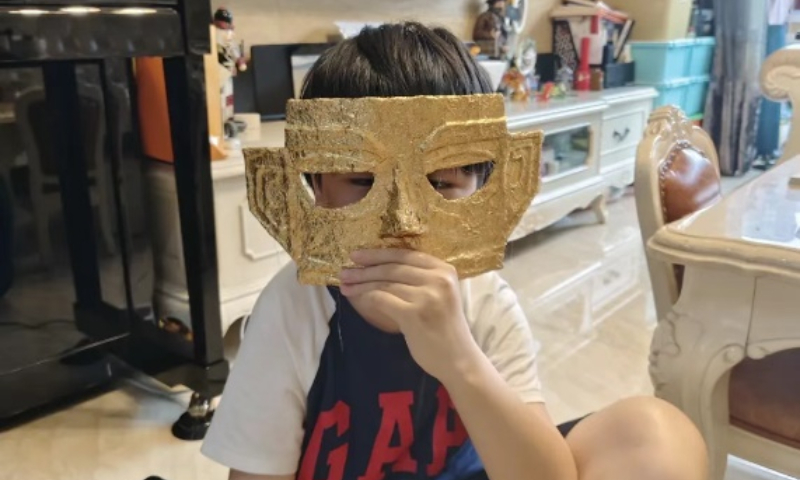
A primary school student from Ningbo, Zhejiang Province, has captured national admiration for his extraordinary replicas of Sanxingdui artifacts (手工艺品), showcasing both artistic skill and scholarly dedication.
Lu Yushao is a sixth grader. He spent his May Day holiday recreating eight iconic artifacts from the 3,000-year-old Bronze Age civilization using everyday materials like cardboard, clay, and foam boards. The smallest piece measures only about 8 centimeters, yet each detail is faithfully reproduced.
Lu’s passion for handicrafts stems from childhood museum tours across China. Lu’s parents often took him to museums across China, where he developed a deep fascination with history, especially the stories behind artifacts. Over time, he grew eager to move beyond mere appreciation, channeling his observations into creative inspiration to “recreate” history with his own hands. His story about Sanxingdui began last summer during a family trip to Sichuan’s Sanxingdui Museum. Fascinated by the artifacts’ intricate designs, he filled notebooks with sketches of patterns from bronze figures’ sleeves and studied documentaries on ancient casting techniques. He wanted to understand not just what they looked like, but how they were made. He even paused documentaries to study key restoration scenes of the bronze sacred tree.
The crafting process proved unexpectedly arduous. “I assumed animal-shaped replicas would be simple,” Lu remarked, pointing to the palm-sized pottery pig replica. “Turns out, they were the hardest to make.” Each piece, shaped over five intense days, blends historical accuracy with creative problem-solving.
Archaeologists and educators have praised Lu’s work for bridging ancient artistry with modern craftsmanship. His replicas — displayed at his school — have sparked discussions about cultural preservation among peers. This young artisan’s story underscores a growing trend: Chinese youth embracing traditional culture through innovative mediums. As Sanxingdui’s global profile rises, Lu’s journey exemplifies how historical reverence and modern creativity can coexist.
原创编写 版权所有 侵权必究! 每日更新 个性化阅读 英语飙升!
1.1. What is specifically stated about the details of Lu’s Sanxingdui replicas?
A They were simplified for faster completion.
B They were precisely matched to the originals.
C They included imaginary elements.
D They prioritized size over accuracy.
解析:选B。B细节理解题。文章第二段末尾明确提到“each detail is faithfully reproduced”可知,每个细节都被忠实还原。选项B用“precisely matched to the originals”(与原件精准匹配)替换原文的同义表达,符合题意。故选B。
2.2. What inspired Lu’s passion for recreating artifacts?
A Family museum trips.
B School projects.
C Online tutorials.
D Art classes.
解析:选A。A细节理解题。根据第三段的“Lu’s parents often took him to museums across China, where he developed a deep fascination with history”可知,卢煜少的父母常带他参观博物馆,他由此对历史产生浓厚兴趣,进而激发创作热情,可推断家庭博物馆之旅是灵感来源。故选A。
3.3. What does the underlined word “arduous” in the passage probably mean?
A Simple.
B Interesting.
C Boring.
D Challenging.
解析:选D。D词义猜测题。文中提到“The crafting process proved unexpectedly arduous”,紧接着说卢煜少原本以为动物形状的手工艺品很简单(simple),但结果却是最难的(hardest),且每件作品需要“高强度制作”(intense days)。由此可知,“arduous”与“simple”形成对比,强调制作过程“困难、具有挑战性”。故选D。
4.4. What does Lu’s story indicate about Chinese youth?
A Lack of interest in history.
B Focus on modern art only.
C Embracing traditional culture innovatively.
D Preferring ancient techniques.
解析:选C。C细节理解题。根据最后一段的“Chinese youth embracing traditional culture through innovative mediums.”可知,卢煜少的故事凸显了中国青年通过创新方式拥抱传统文化的趋势。故选C。
